The first day of winter, and it’s a cold and dreary afternoon. A perfect day for baking.
Of course, good nutrition, and sensible diets dictate that I don’t bake too often, but when I do, it better be something I love.
This time of year I love winter squash, especially the butternut types, like ‘Waltham’, or my favorite, ‘Greek Sweet Red’. Pair the squash with pastry, and I find myself in my very own little piece of heaven.
By request, I’m sharing not one, but two of my favorite recipes for preparing butternut squash in pastry. A simple, rustic, Galette, and filled puff pastry pockets.
Both recipes use very similar ingredients for the filling, which is why I’m including them both. Compared to the galette, the pockets have the addition of kale, and I substitute Gruyère for feta. The biggest difference between them though is the shape, and the type of pastry being used – Galette dough, versus a puff pastry. Note, however, that the galette dough will hold up much better if you expect to have left-overs, even refrigerated, as puff pastry has a very short shelf life once baked.
Roasted Butternut Squash Galette
Yield: 6-8 Servings
Galette Pastry:
1 1/2 Cups All-Purpose Flour
1/4 Tsp Salt
1 Tbsp Finely Chopped Fresh Sage
10 Tbsp (5 oz) cold unsalted butter, cut into 1/2 inch pieces
1/3 Cup ice-cold water
Filling:
2 lb Butternut Squash – peeled, seeded, and sliced half inch thick
Extra Virgin Olive Oil
1/2 Tsp Kosher Salt
1 Large Yellow Onion
6 Ounces Feta Cheese, crumbled
1-2 Ounces of Grated Gruyère (optional)
Egg Wash:
1 Large Egg, lightly beaten
1 Tbsp water
Equipment:
Food Processor – fitted with a metal cutting blade
Rolling Pin
Half Sheet Pan
Parchment Paper
Preheat Oven: 475 F for roasting squash (lower to 375 F for baking Galette)
Directions
Prepare the Dough:
Put the flour, salt, and chopped sage into the work bowl, and pulse briefly to combine. Add the butter pieces, and process for 5 one second pulses, until the mixture resembles coarse crumbs. Do not overmix, or the dough will toughen.
Add the water and pulse for 10 more seconds, until the dough starts to come together. Remove the dough from the bowl, and pull together with your hands into a ball, and then flatten into a disk. Wrap the dough, or place in an airtight storage container to prevent drying, and refrigerate for 1 hour. While the dough rests, prepare the filling.
Prepare the Filling:
Preheat the oven to 475 F.
Peel and seed the butternut squash, split length-wise, and then slice into half inch thick slices. Place the squash in a bowl, and toss with 1-2 Tbsp of olive oil, and arrange in a single layer on a half sheet pan.
Roast for 25-35 minutes, stirring once halfway through roasting, until the squash is just tender, and starting to turn brown on the edges.
While the squash is roasting, split the onion from top to root, and slice each half into 1/4 inch slices. Add 3 Tbsp of olive oil to a large skillet over medium-high heat. Once the oil shimmers, add the onion, and stir until coated. Reduce the heat to medium, and cook, stirring occasionally, until lightly caramelized. Season with a little kosher salt to taste.
Assemble the Galette:
Reduce the oven temperature to 375 F.
Line a half sheet pan with parchment paper, trimmed to fit.
Remove the dough from the refrigerator, and allow to sit at room temperature for 5-10 minutes before rolling. Dust the work surface lightly with flour, and roll the dough to a 13-14 inch diameter circle.
Carefully transfer the pastry to the parchment lined pan.
Arrange the caramelized onion in the center of the dough, in an even layer, leaving a 3 inch border around the edge. Sprinkle the onion with feta cheese, and arrange the roasted butternut squash on the top.
Fold the few inches of the pastry border up, pleating around the edge as necessary to maintain a circular shape.
If desired, grate a little Gruyère over the squash.
Brush the outside of the pastry with egg wash, and bake at 375 F for 40-50 minutes until the crust is golden.
Allow to cool for a few minutes, and serve alone, with a side salad, or wilted kale.
Butternut Pastry Pockets
Yield: 9 Pockets
The advantage of pastry pockets is that they’re easily portable, and can be eaten out of hand, which makes them great for picnics, or buffets. As these pockets are sealed, unlike the Galette, I also like to add some winter kale to this recipe, as the kale doesn’t dry out in the oven during baking.
As for the pastry for this recipe is alright to cheat*, and use frozen dough. It really is. Traditional puff pastry takes at least half a day to make from scratch, and ideally requires the use of expensive European-style butters that have a reduced water content compared to our domestic American butter. As such, I admit, on the rare occasion I use puff pastry these days, even I don’t always make my own. I know…**gasp**…the shock and horror!
Although puff pastry does not hold well after being baked, once the pockets are filled, and sealed, but BEFORE the egg wash is applied, you can freeze the pockets UNBAKED, to bake them later if you choose. If you only want to serve a couple of pockets for a meal, it’s easy to freeze the rest for later.
Filling:
2 lb Butternut Squash – peeled, seeded, and sliced half inch thick
Extra Virgin Olive Oil
1/2 Tsp Kosher Salt
1 Large Yellow Onion
1 Large bunch of Kale (de-stemmed), or Spinach, rough chopped
2 oz Grated Gruyere
2-3 Tbsp Crumbled Gorgonzola
Puff Pastry:
1 pkg. Frozen Puff Pastry Sheets (2 Sheets ~ 18 oz. total), thawed
– or –
If you’re brave, and have the time, make your own. A quick ‘Rough-Puff’ pastry recipe I recommend, as a substitute that only takes about an hour, can be found in Rose Levy Beranbaum’s book The Pie and Pastry Bible, page 420. It doesn’t puff as much as a traditional puff pastry, but it’s still good.
Egg Wash:
1 Large Egg, lightly beaten
1 Tbsp water
Equipment:
Food Processor – fitted with a metal cutting blade
Rolling Pin
Sharp Knife, or Pizza Wheel-Cutter
Half Sheet Pan
Parchment Paper
Preheat Oven: 475 F for roasting squash (lower to 375 F for baking Pockets)
Prepare the Filling:
The directions for roasting the squash, and caramelizing the onion, are the same as for the galette above.
In a saute pan over medium heat add 2-3 tablespoons of olive oil. Once the oil is hot, drop the chopped kale into the pan, and toss to coat with oil. Cover the pan, and reduce the heat to medium-low, and cook for 10-15 minutes, stirring occasionally, until tender.
Assemble the Pockets:
Gently roll the thawed dough sheets into even, approximately 10-11 inch, squares. Use flour for dusting sparingly.
Transfer one sheet to a parchment lined half sheet pan.
Lightly mash the roasted squash with the tines of a fork, to make the squash easier to scoop. Evenly space 9 small scoops of squash across one of the pastry sheets. Top with a little of the caramelized onion, wilted kale, grated Gruyere, and a light sprinkle of the crumbled Gorgonzola.
Brush the egg wash around the edges of the dough, and lay the second sheet of puff pastry over the top.
Gently press the edges together, and using a sharp knife, or wheel-cutter, cut between the seams to form 9 individual pastry pockets. It’s imperative that the blade is SHARP, or the pastry edges will not puff. Crimp around the edges of each pocket with the tines of a fork to ensure the seams are sealed. Cut 2 or 3 half-inch slits in the top of each pocket for steam to escape during baking.
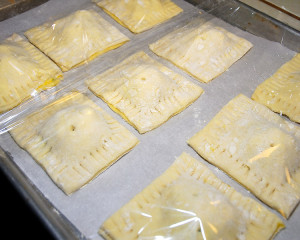
Freeze the pockets on a covered baking sheet, to prevent the dough from drying out. Once frozen, transfer them to freezer storage containers
At this point the pockets may be frozen for baking later.
If baking right away, brush the surface of each pocket with egg wash, and bake for 20 minutes, turning once half way through baking, until the pastry is puffed, and golden.
Transfer to a cooling rack, and allow to cool for 10 minutes before serving.
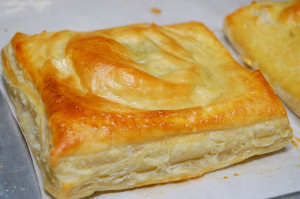
Next time try something different. Spinach and mushroom, sausage and onion, the possibilities are endless!
If that’s still not enough, you can take the same filling ingredients from the pockets, add some fresh mozzarella, and top our pizza dough with it, for a winter take on a pizza.
What’s not to love about butternut squash?! It’s alright, the diet doesn’t start (again) until the New Year. Enjoy!
*I will post a recipe, with technique, for homemade puff pastry soon, but after the Curbstone Valley Elves are done with the rest of their holiday baking, as they’ve fallen behind, and still have a LOT of work to do!
———————
If you’re looking for more Butternut Squash Recipes, try our recipes for:
Roasted Butternut Squash Ravioli

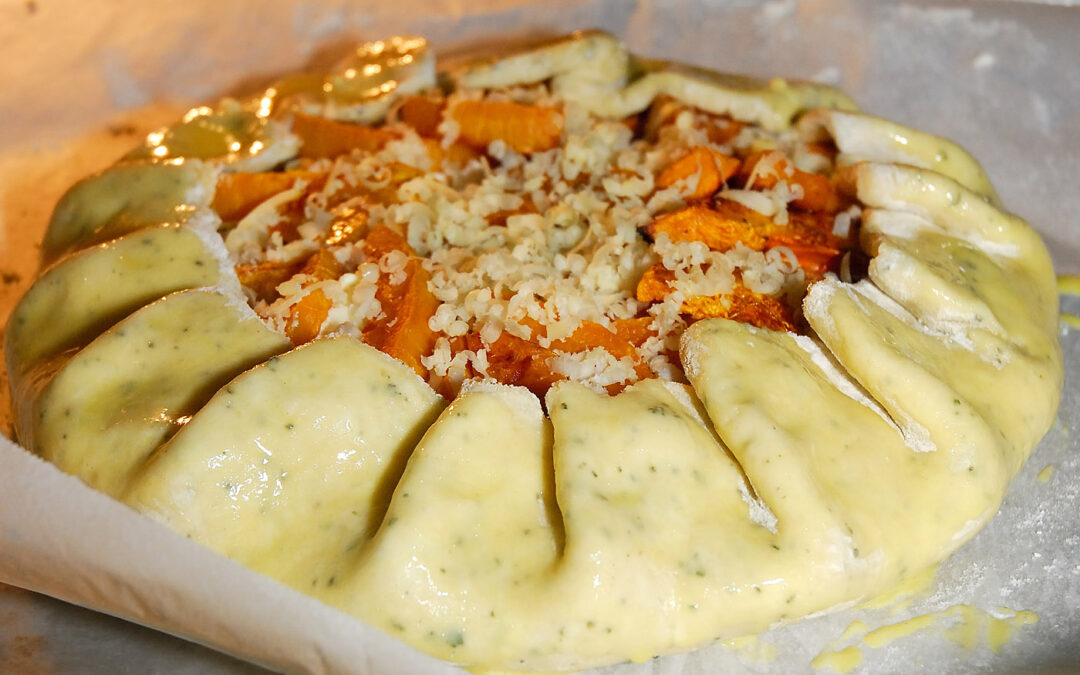
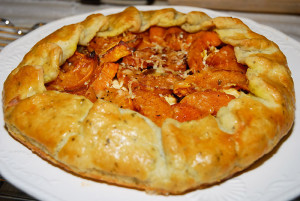
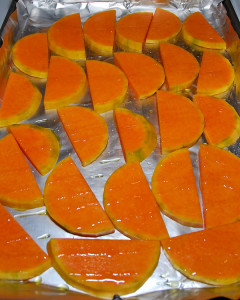
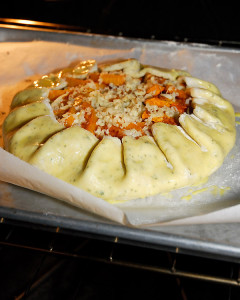
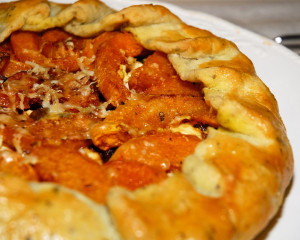
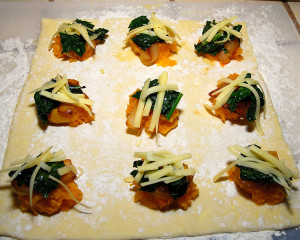
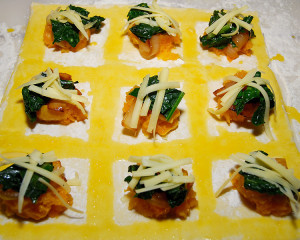
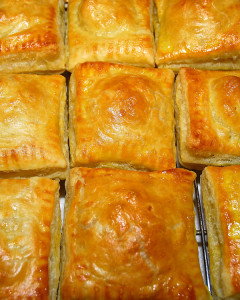
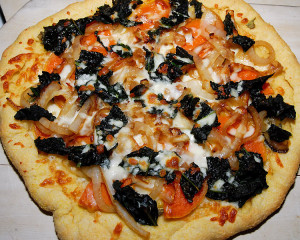







Wow, I am really hungry now! Soup is all I ever really see done with butternut squash (which I’m not complaining about, because it’s a delicious soup!) but these look fantastic!
Thanks!
I’m a huge fan of butternut squash soup…with a large hunk of fresh crusty bread. Some of these though have definitely become favorites for us this time of year!
Clare I had never considered these unique ways to use the squash…I had not grown this squash as I was unsure how I would eat it but the rather bland ways my mother made it…but you have intrigued me and given me ideas for many ways to use veggies…yummy…Happy Holidays Clare!!
If like me, you were subjected to less than appealing winter squashes in the past, I do think that butternut is one of the sweetest, and most versatile squashes to grow for use in the winter kitchen. I love that it’s not watery, it roasts beautifully, which makes it even sweeter, and it tastes wonderful. I would highly recommend trying the galette. It’s easy, and I think you’ll be surprised. It’s definitely NOT bland! 🙂
Hmm. I’ve got some butternut squash that needs cooking; I think I might try the galette tomorrow for dinner. Thanks for sharing. -Jean
I hope you enjoy the galette. Let us know how it turned out for you!
I made it for dinner tonight — cutting the recipe in half for my one-person household and then halving the butter in the dough. It was delicious; it smelled so good while it was baking that I could barely wait for it to be done. The best part is that I still have a serving left for another meal. Thanks again for the yummy recipe.
Jean, so happy you liked it! The herbs in the pastry really do make for a wonderful aroma while the galette bakes! I found the pastry held up very well overnight in the fridge too. Didn’t go soggy at all!
Your recipes always make me hungry!! Happy holidays!
Happy holidays! I hope you had a chance to indulge a little this season 😉
Thank you so much for the galette recipe. I made it for New Year’s and it was delicious. (Of course, yours was prettier, but it still tasted great.) I am a great lover of savory pastries and of ways to use veggies like the squash that had been sitting on the counter for a month!
(Love the blog too. And the goats!)
So glad you enjoyed, Birgitt! I love savory pastries too, especially in the fall and winter months. The galette is great as it’s so versatile. Depending on the filling, you could use chopped fresh rosemary, or thyme, in the crust, or leave out the herbs, and add a touch of sugar for a fruit based galette instead. I suspect though, with as much squash as we still have to get through this winter, I’ll be making this same recipe a few more times in the coming weeks 🙂